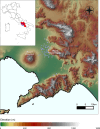Predicting the invasion risk of Bactrocera dorsalis in Italy under climate and land cover change
- PMID: 41062602
- PMCID: PMC12508463
- DOI: 10.1038/s41598-025-18890-2
Predicting the invasion risk of Bactrocera dorsalis in Italy under climate and land cover change
Abstract
Bactrocera dorsalis, the oriental fruit fly (OFF), is a highly polyphagous and multivoltine invasive insect threatening over 600 fruit crop species globally. Originating in Asia, OFF has spread to Africa, Europe, and the United States. This study assessed the current and future potential distribution of OFF in Italy, a likely entry point for its invasion into Europe. Climate and land cover changes projected for 2070 and 2100 were considered. Potential connectivity corridors were identified, and habitat suitability was evaluated within orchards and vineyards. Ecological Niche Models (ENMs) and connectivity analyses revealed a dramatic increase in suitable habitats for OFF under future scenarios. The potential distribution is projected to expand on average by over 1600% under mild conditions and over 7000% under severe conditions, up to 2100. Key environmental factors include mean temperature of the driest quarter, isothermality, precipitation during the driest months, and proximity to forests, urban areas, and roads. Our findings suggest a significant rise in OFF suitability within agricultural areas, particularly vineyards and orchards, posing increased risks to these sectors. Effective management strategies - possibly supported by ecological modelling such as this study - should focus on mass trapping, habitat management, and public awareness to mitigate and contain this pest's spread. These predictions are based on the working assumption that B. dorsalis is locally acclimatized in inland Campania, southern Italy. Although definitive evidence of establishment is still pending, repeated detections in the same area over four consecutive years support the use of Italian records in risk modelling as an early warning strategy.
Keywords: Agricultural pest; Connectivity corridors; Ecological niche models; Global change.; Invasion risk; Invasive alien species.
© 2025. The Author(s).
Conflict of interest statement
Declarations. Competing interests: The authors declare no competing interests.
Figures






References
-
- Clarke, A. R. et al. Invasive phytophagous pests arising through a recent tropical evolutionary radiation: The Bactrocera dorsalis complex of fruit flies. Annu. Rev. Entomol.50, 293–319. 10.1146/annurev.ento.50.071803.130428 (2005). - PubMed
-
- EPPO (European and Mediterranean Plant Protection Organization). EPPO datasheet: Bactrocera dorsalis. EPPO Bull.13, 1–9 (2021).
-
- Dominiak, B. C. & Hoskins, J. L. Managing oriental fruit fly, Bactrocera dorsalis (Hendel): Prioritising host plants using the host reproduction number. Int. J. Trop. Insect Sci.45, 1249–1275. 10.1007/s42690-025-01514-7 (2025).
-
- EFSA. Pest survey card on Bactrocera dorsalis. EFSA Support. Publ.18, 30. 10.2903/sp.santa.2021.en-1999 (2022).
-
- Nugnes, F. et al. The enemy is already inside! Bactrocera dorsalis is a serious threat to European orchards and crops. Entomol. Gen.44, 1243–1251. 10.1127/entomologia/2024/2613 (2024).
MeSH terms
Supplementary concepts
Grants and funding
LinkOut - more resources
Full Text Sources
Medical

